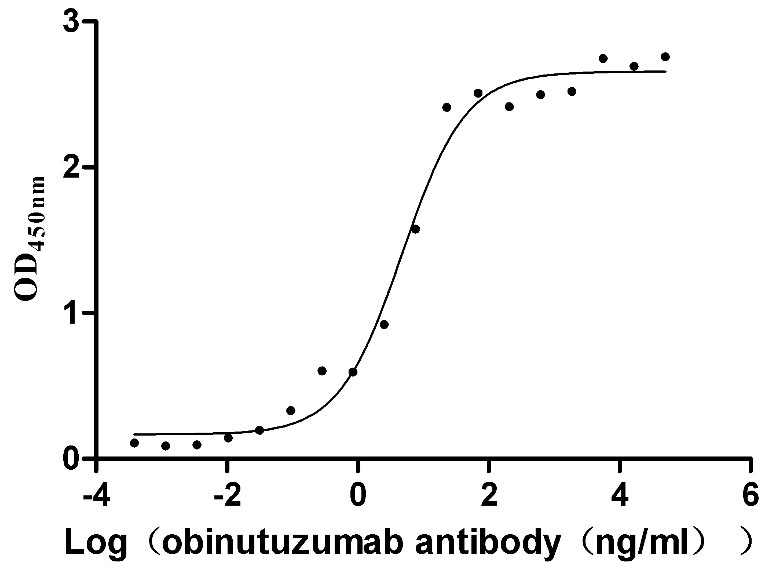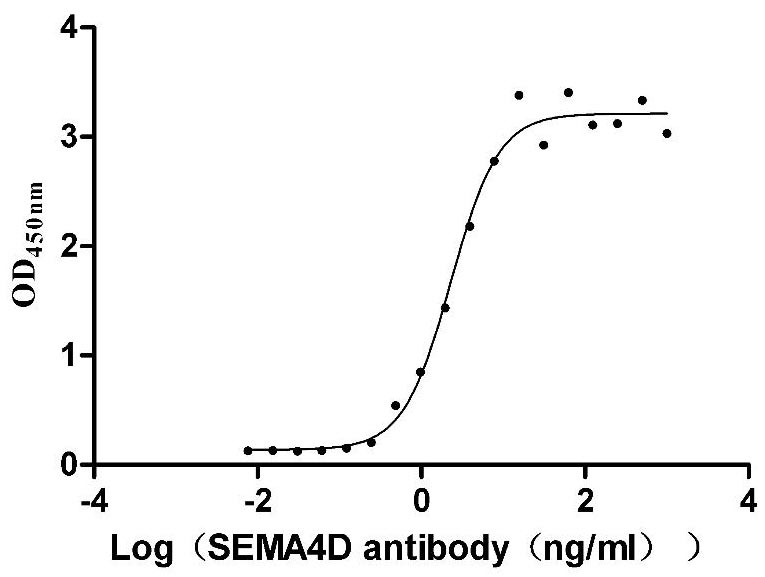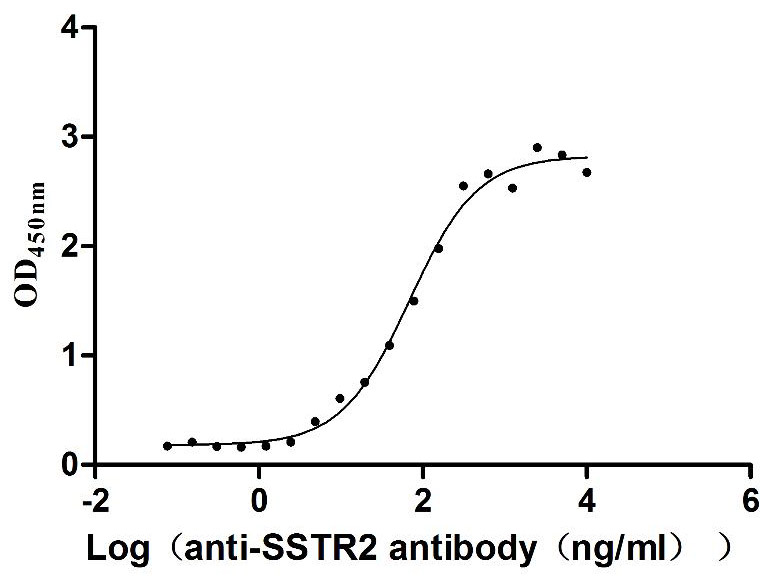Recombinant Human Rhodopsin (RHO), partial
-
中文名稱:人RHO重組蛋白
-
貨號:CSB-YP019681HU
-
規(guī)格:
-
來源:Yeast
-
其他:
-
中文名稱:人RHO重組蛋白
-
貨號:CSB-EP019681HU-B
-
規(guī)格:
-
來源:E.coli
-
共軛:Avi-tag Biotinylated
E. coli biotin ligase (BirA) is highly specific in covalently attaching biotin to the 15 amino acid AviTag peptide. This recombinant protein was biotinylated in vivo by AviTag-BirA technology, which method is BriA catalyzes amide linkage between the biotin and the specific lysine of the AviTag.
-
其他:
-
中文名稱:人RHO重組蛋白
-
貨號:CSB-BP019681HU
-
規(guī)格:
-
來源:Baculovirus
-
其他:
-
中文名稱:人RHO重組蛋白
-
貨號:CSB-MP019681HU
-
規(guī)格:
-
來源:Mammalian cell
-
其他:
產(chǎn)品詳情
-
純度:>85% (SDS-PAGE)
-
基因名:
-
Uniprot No.:
-
別名:CSNBAD1; MGC138309; MGC138311; OPN 2; OPN2; opsd; OPSD_HUMAN; opsin 2; Opsin 2 rod pigment; Opsin-2; Opsin2; Retinitis Pigmentosa 4; Retinitis pigmentosa 4 autosomal dominant; RHO; Rhodopsin; RP 4; RP4
-
種屬:Homo sapiens (Human)
-
蛋白長度:Partial
-
蛋白標(biāo)簽:Tag?type?will?be?determined?during?the?manufacturing?process.
The tag type will be determined during production process. If you have specified tag type, please tell us and we will develop the specified tag preferentially. -
產(chǎn)品提供形式:Lyophilized powder
Note: We will preferentially ship the format that we have in stock, however, if you have any special requirement for the format, please remark your requirement when placing the order, we will prepare according to your demand. -
復(fù)溶:We recommend that this vial be briefly centrifuged prior to opening to bring the contents to the bottom. Please reconstitute protein in deionized sterile water to a concentration of 0.1-1.0 mg/mL.We recommend to add 5-50% of glycerol (final concentration) and aliquot for long-term storage at -20℃/-80℃. Our default final concentration of glycerol is 50%. Customers could use it as reference.
-
儲存條件:Store at -20°C/-80°C upon receipt, aliquoting is necessary for mutiple use. Avoid repeated freeze-thaw cycles.
-
保質(zhì)期:The shelf life is related to many factors, storage state, buffer ingredients, storage temperature and the stability of the protein itself.
Generally, the shelf life of liquid form is 6 months at -20°C/-80°C. The shelf life of lyophilized form is 12 months at -20°C/-80°C. -
貨期:Delivery time may differ from different purchasing way or location, please kindly consult your local distributors for specific delivery time.Note: All of our proteins are default shipped with normal blue ice packs, if you request to ship with dry ice, please communicate with us in advance and extra fees will be charged.
-
注意事項(xiàng):Repeated freezing and thawing is not recommended. Store working aliquots at 4°C for up to one week.
-
Datasheet :Please contact us to get it.
相關(guān)產(chǎn)品
靶點(diǎn)詳情
-
功能:Photoreceptor required for image-forming vision at low light intensity. Required for photoreceptor cell viability after birth. Light-induced isomerization of the chromophore 11-cis-retinal to all-trans-retinal triggers a conformational change that activates signaling via G-proteins. Subsequent receptor phosphorylation mediates displacement of the bound G-protein alpha subunit by the arrestin SAG and terminates signaling.
-
基因功能參考文獻(xiàn):
- using cryo-electron microscopy, it is shown that the major interactions between activated rhodopsin and Gi are mediated by the C-terminal helix of the Gi alpha-subunit, which is wedged into the cytoplasmic cavity of the transmembrane helix bundle and directly contacts the amino terminus of helix 8 of rhodopsin PMID: 29899450
- The identification of the pathogenic variant p.E113 K is the first description of a naturally-occurring mutation in the Schiff base counterion of RHO in patients. The heterozygous mutation c.337G > A in exon 1 was confirmed in the retinitis pigmentosa index patient as well as in five stationary night blindness-affected relatives. PMID: 27812022
- data provide the first evidence that T17M rhodopsin mutant disrupts C3 secretion via the induction of ROS and the suppression of TWIST1. PMID: 28569420
- Wild-type opsin mainly formed oligomers. Only a minor population formed aggregates. The G188R opsin mutant mainly formed aggregates. When wild-type opsin and G188R opsin were coexpressed in cells, properly folded wild-type opsin did not aggregate with G188R opsin and was trafficked normally to the cell membrane. The autosomal dominant phenotype due to misfolded opsin mutants is not due to WT-mutant physical interaction. PMID: 27117643
- Data suggest that retinitis pigmentosa-associated mutation G51A behaves differently in human rhodopsin compared to bovine rhodopsin; human rhodopsin is more thermally stable than ancestral ancestrally reconstructed mammalian rhodopsin. PMID: 28369862
- These findings provide a new understanding of the effects of oxLDL on endothelial proliferation, which is essential for developing new treatments against neovascularization and progression of atherosclerosis. PMID: 28701359
- Study reports an X-ray free electron laser crystal structure of the rhodopsin-arrestin complex, in which the phosphorylated C terminus of rhodopsin forms an extended intermolecular beta sheet with the N-terminal beta strands of arrestin. Phosphorylation was detected at rhodopsin C-terminal tail residues T336 and S338. PMID: 28753425
- results suggest that nonsense-mediated mRNA decay modulates the severity of retinitis pigmentosa in patients with nonsense mutations in the rhodopsin gene PMID: 26416182
- both the charged G90D(2.57) and the hydrophobic T94I(2.61) mutation alter the dark state by weakening the interaction between the Schiff base (SB) and its counterion E113(3.28) We propose that this interference with the tight regulation of the dim light photoreceptor rhodopsin increases background noise in the visual system and causes the loss of night vision characteristic for CSNB patients. PMID: 27458239
- A mutation-independent strategy appears viable in this specific context but certain mutations could significantly influence ribozyme or RNAi efficacy through impact on accessibility at the target annealing site/region. PMID: 28715844
- a recurrent missense mutation (c.403C > T, p.R135W) in the rhodopsin (RHO) gene cosegregated with all retinitis pigmentosa affected individuals in the family. PMID: 26794436
- Autosomal recessive retinitis pigmentosa with homozygous rhodopsin mutation E150K and non-coding cis-regulatory variants in CRX-binding regions of SAMD7. PMID: 26887858
- Functional role of positively selected amino acid substitutions in mammalian rhodopsin evolution has been uncovered for a large number of mammalian species. PMID: 26865329
- Our study shows that RHO mutations are a major cause of adRP in this cohort and are responsible for 28% of adRP families. PMID: 26962691
- analysis of the crystal structure of the rhodopsin-arrestin complex PMID: 26467309
- A whole-exome sequencing approach led to identification of a deletion in RHO through detection of a new linked variant in COL6A6 in autosomal dominant retinitis pigmentosa. PMID: 26321861
- These insights into the dynamics of the ground states and the early photocycle stages enhance our understanding of the channel function of Channel rhodopsin. PMID: 26114863
- Studies indicate that misfolding of rhodopsin can result in disruptions in cellular protein homeostasis, or proteostasis. PMID: 26427449
- FIP3 (RAB11-FIP3) promotes the activity of Rab11a and the ASAP1 in the Arf4-dependent ciliary transport of the sensory receptor rhodopsin. PMID: 25673879
- RHO polymorphisms (rs7984, rs2855557 and rs2410) and haplotypes may confer remarkable susceptibility to age-related macular degeneration PMID: 26045836
- The study identified a RHO gene mutation (p.Thr58Met) not previously reported in RP in a patient with sector retinitis pigmentosa (RP). PMID: 25265376
- Similar vacuolization in photoreceptor outer segment discs of transgenic mice expressing human rhodopsin with a T17M mutation or non-glycosylated form of rhodopsin was found. Non-glycosylated rhodopsin is unstable and is regulated via ubiquitin pathway PMID: 25637522
- reveal the spectrum and frequency of RHO mutations in Chinese patients with different forms of retinitis pigmentosa and demonstrate that RHO mutations account for a high proportion of autosomal dominant retinitis pigmentosa cases PMID: 25221422
- show that although the basic activation pathways of human and bovine rhodopsin are similar, structural deviations exist in the inactive conformation and during receptor activation, even between closely related rhodopsins PMID: 26105054
- Rer1p regulates the ER retention of immature or misfolded rhodopsin and modulates its intracellular trafficking through the early secretory pathway. PMID: 25096327
- crystal structure of a constitutively active form of human rhodopsin bound to a pre-activated form of the mouse visual arrestin, determined by serial femtosecond X-ray laser crystallography PMID: 26200343
- RHO has an intrinsic water pathway, which in the receptors' resting state is interrupted by a hydrophobic layer of amino acid residues and upon agonist binding, opened to a continuous intrinsic water channel. PMID: 25203160
- ERdj5 is a member of the proteostasis network that regulates rod opsin biogenesis and supports a role for disulfide bond formation/reduction in rod opsin biogenesis and disease. PMID: 25055872
- This retrospective study provides a wide spectrum of mutations in the RHO gene in Spanish patients with autosomal dominant Retinitis Pigmentosa . PMID: 25408095
- Data indicate that transfected human channelrhodopsin-2 (rhodopsin) increased the action potential in the rat spinal cord and activated the calcium channel in dorsal root ganglion neurons. PMID: 25171072
- In this report we describe a New Zealand family, of European heritage, affected by a sectoral type RP phenotype in association with a novel rhodopsin mutation (proline-170-histidine) in a highly conserved site. PMID: 24918165
- Data indicate that the number of nanodomains present in a single disc was dependent on the number of rhodopsin molecules incorporated into the membrane. PMID: 25305340
- Electron paramagnetic resonance spectra of the spin-labeled samples indicate that the extracellular residues of RHO retain more rigidity in the denatured states than the cytoplasmic residues. PMID: 25268658
- tHE results OF THIS STUDY identify a novel pathogenic mechanism in which the glycosylation-deficient rhodopsins are destabilized by light activation. PMID: 25274813
- There is a correlation between the stability of rhodopsin mutations and disease severity and levels of membrane-bound rhodopsin. PMID: 24520188
- Many biochemical studies have demonstrated that P23H mutation induces rhodopsin (RHO) misfolding leading to endoplasmic reticulum stress. PMID: 24664733
- These studies indicate that activation of either IRE1, ATF6, or PERK prevents mutant rhodopsin from accumulating in the cells. PMID: 24664756
- It regulates relaxation of vascular smooth muscle. PMID: 24717605
- In the dark, rhodopsin 11-cis retinal chromophore serves as an inverse agonist to lock the receptor in an inactive state. (Review) PMID: 24183693
- development of rod photoreceptors in TgP23H swine embryos. PMID: 24618321
- Retinitis pigmentosa mutants provide insight into the role of the N-terminal cap in rhodopsin folding, structure, and function. PMID: 24106275
- This study demonistrated that rhodopsin P23H mutation cause early degeneration of retin. PMID: 23557623
- The purpose of this study was to test for mechanisms by which the autosomal dominant rhodopsin mutation Ter349Glu causes an early, rapid retinal degeneration. PMID: 23940033
- X-ray crstallographic analysis of rhodopsin reveals the congenital stationary night blindness-causing G90D mutation introduces a salt bridge with K296. PMID: 23579341
- The S186W mutant thermally destabilizes rhodopsin by disrupting a hydrogen bond network at the receptor's active site. PMID: 23625926
- The c.233A>T mutation at RHO exon 1 caused sectorial retinitis pigmentosa in a pedigree with intrafamilial clinical heterogeneity. PMID: 23402891
- Two mutations in the RHO gene have been found in two Chinese families with retinitis pigmentosa. PMID: 23288993
- Pathogenic mutations in rhodopsin can lead to autosomal dominant retinitis pigmentosa. PMID: 22791210
- Data suggest that BiP (HSPA5) is important for maintaining the solubility of rod opsin in the endoplasmic reticulum. PMID: 22855534
- Less severe phenotypes occurred in patients with p.R135W in rhodopsin. PMID: 23049240
顯示更多
收起更多
-
相關(guān)疾病:Retinitis pigmentosa 4 (RP4); Night blindness, congenital stationary, autosomal dominant 1 (CSNBAD1)
-
亞細(xì)胞定位:Membrane; Multi-pass membrane protein. Cell projection, cilium, photoreceptor outer segment.
-
蛋白家族:G-protein coupled receptor 1 family, Opsin subfamily
-
組織特異性:Rod shaped photoreceptor cells which mediate vision in dim light.
-
數(shù)據(jù)庫鏈接:
Most popular with customers
-
Recombinant Human Nectin-4 (NECTIN4), partial (Active)
Express system: Mammalian cell
Species: Homo sapiens (Human)
-
Recombinant Human B-lymphocyte antigen CD20 (MS4A1)-VLPs (Active)
Express system: Mammalian cell
Species: Homo sapiens (Human)
-
Recombinant Macaca mulatta Semaphorin-4D isoform 1 (SEMA4D), partial (Active)
Express system: Mammalian cell
Species: Macaca mulatta (Rhesus macaque)
-
Recombinant Human Somatostatin receptor type 2 (SSTR2)-VLPs (Active)
Express system: Mammalian cell
Species: Homo sapiens (Human)
-
Recombinant Human V-set and immunoglobulin domain-containing protein 4 (VSIG4), partial (Active)
Express system: Mammalian cell
Species: Homo sapiens (Human)
-
Recombinant Human B- and T-lymphocyte attenuator(BTLA), partial (Active)
Express system: Mammalian cell
Species: Homo sapiens (Human)

















